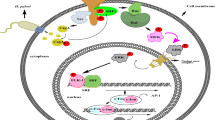Abstract
MicroRNAs have been implicated as a central regulator of the immune system. We have previously reported that Helicobacter pylori (H. pylori) was able to increase the expression of miR-146a, and miR-146a may negatively regulate H. pylori-induced inflammation, but the exact mechanism of how H. pylori contribute the induction of miR-146a is not clear. Here, we attempted to assess the role of H. pylori related proinflammatory cytokines including interleukin (IL)-8, tumor necrosis factor (TNF)-α, and interleukin (IL)-1β, and cytotoxin-associated gene A (CagA) virulence factor on the induction of miR-146a. We found that IL-8, TNF-α, and IL-1β could contribute to the induction of miR-146a in gastric epithelial cell HGC-27 in NF-κB-dependent manner, while the induction of miR-146a upon H. pylori stimulation was independent of above proinflammatory cytokines. Furthermore, overexpression of miR-146a reduced H. pylori—induced IL-8, TNF-α, and IL-1β. However, CagA had no effect on the miR-146a induction. Taken together, our study suggest that proinflammatory cytokines IL-8, TNF-α, and IL-1β could contribute to the induction of miR-146a during H. pylori infection, while CagA is not necessarily required for miR-146a induction. miR-146a may function as novel negative regulators to modulate the inflammation.



Similar content being viewed by others
References
Bartel DP (2004) MicroRNAs: genomics, biogenesis, mechanism, and function. Cell 116:281–297
Ambros V (2004) The functions of animal microRNAs. Nature 431:350–355
Rodriguez A, Vigorito E, Clare S, Warren MV, Couttet P et al (2007) Requirement of bic/microRNA-155 for normal immune function. Science 316:608–611
Xiao C, Rajewsky K (2009) MicroRNA control in the immune system: basic principles. Cell 136:26–36
Taganov KD, Boldin MP, Baltimore D (2007) MicroRNAs and immunity: tiny players in a big field. Immunity 26:133–137
Lindsay MA (2008) MicroRNAs and the immune response. Trends Immunol 29:343–351
Thai TH, Calado DP, Casola S, Ansel KM, Xiao C et al (2007) Regulation of the germinal center response by microRNA-155. Science 316:604–608
Xiao B, Liu Z, Li BS, Tang B, Li W et al (2009) Induction of microRNA-155 during Helicobacter pylori infection and its negative regulatory role in the inflammatory response. J Infect Dis 200:916–925
Liu Z, Xiao B, Tang B, Li B, Li N et al (2010) Up-regulated microRNA-146a negatively modulate Helicobacter pylori-induced inflammatory response in human gastric epithelial cells. Microbes Infect 12:854–863
Yoshida N, Granger DN, Evans DJ Jr, Evans DG, Graham DY et al (1993) Mechanisms involved in Helicobacter pylori-induced inflammation. Gastroenterology 105:1431–1440
Yamaoka Y, Kita M, Kodama T, Sawai N, Kashima K et al (1997) Induction of various cytokines and development of severe mucosal inflammation by cagA gene positive Helicobacter pylori strains. Gut 41:442–451
Mooney C, Keenan J, Munster D, Wilson I, Allardyce R et al (1991) Neutrophil activation by Helicobacter pylori. Gut 32:853–857
Takashima M, Furuta T, Hanai H, Sugimura H, Kaneko E (2001) Effects of Helicobacter pylori infection on gastric acid secretion and serum gastrin levels in Mongolian gerbils. Gut 48:765–773
Perry MM, Moschos SA, Williams AE, Shepherd NJ, Larner-Svensson HM et al (2008) Rapid changes in microRNA-146a expression negatively regulate the IL-1beta-induced inflammatory response in human lung alveolar epithelial cells. J Immunol 180:5689–5698
Li J, Wan Y, Guo Q, Zou L, Zhang J et al (2010) Altered microRNA expression profile with miR-146a upregulation in CD4+ T cells from patients with rheumatoid arthritis. Arthritis Res Ther 12:R81
Censini S, Lange C, Xiang Z, Crabtree JE, Ghiara P et al (1996) cag, a pathogenicity island of Helicobacter pylori, encodes type I-specific and disease-associated virulence factors. Proc Natl Acad Sci USA 93:14648–14653
Nomura AM, Perez–Perez GI, Lee J, Stemmermann G, Blaser MJ (2002) Relation between Helicobacter pylori cagA status and risk of peptic ulcer disease. Am J Epidemiol 155:1054–1059
Brandt S, Kwok T, Hartig R, Konig W, Backert S (2005) NF-kappaB activation and potentiation of proinflammatory responses by the Helicobacter pylori CagA protein. Proc Natl Acad Sci USA 102:9300–9305
Suzuki M, Mimuro H, Kiga K, Fukumatsu M, Ishijima N et al (2009) Helicobacter pylori CagA phosphorylation-independent function in epithelial proliferation and inflammation. Cell Host Microbe 5:23–34
Xiao B, Li W, Guo G, Li B, Liu Z et al (2009) Identification of small noncoding RNAs in Helicobacter pylori by a bioinformatics-based approach. Curr Microbiol 58:258–263
Williams AE, Perry MM, Moschos SA, Larner-Svensson HM, Lindsay MA (2008) Role of miRNA-146a in the regulation of the innate immune response and cancer. Biochem Soc Trans 36:1211–1215
Sonkoly E, Stahle M, Pivarcsi A (2008) MicroRNAs and immunity: novel players in the regulation of normal immune function and inflammation. Semin Cancer Biol 18:131–140
Nakasa T, Miyaki S, Okubo A, Hashimoto M, Nishida K et al (2008) Expression of microRNA-146 in rheumatoid arthritis synovial tissue. Arthritis Rheum 58:1284–1292
Allison CC, Kufer TA, Kremmer E, Kaparakis M, Ferrero RL (2009) Helicobacter pylori induces MAPK phosphorylation and AP-1 activation via a NOD1-dependent mechanism. J Immunol 183:8099–8109
Fassi Fehri L, Koch M, Belogolova E, Khalil H, Bolz C et al (2010) Helicobacter pylori induces miR-155 in T cells in a cAMP-Foxp3-dependent manner. PLoS One 5(3):e9500
Acknowledgments
The authors would like to thank Dr. Masato Suzuki and Prof. Chihiro Sasakawa (Department of Microbiology and Immunology, The Institute of Medical Science, The University of Tokyo) for providing ∆cagA NCTC11637 H. pylori strain and CagA expression plasmid. This work was supported by the Scientific Innovation Research Foundation of Third Military Medical University (No. 2009XQN20), and Chinese National Natural Science Foundation project (No. 30770113), and grant from the Project of State Key Laboratory of Trauma, Burns, and Combined Injury (No. SKF201012).
Author information
Authors and Affiliations
Corresponding authors
Additional information
Na Li and Xiang Xu contributed equally to this work.
Rights and permissions
About this article
Cite this article
Li, N., Xu, X., Xiao, B. et al. H. pylori related proinflammatory cytokines contribute to the induction of miR-146a in human gastric epithelial cells. Mol Biol Rep 39, 4655–4661 (2012). https://doi.org/10.1007/s11033-011-1257-5
Received:
Accepted:
Published:
Issue Date:
DOI: https://doi.org/10.1007/s11033-011-1257-5




